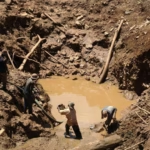When you’ve experienced a water leak that happened seemingly out of nowhere and started wreaking havoc on your home, it’s essential that you take the right steps, even though you might be tempted to just start panicking.
Although we understand that urge, it’s critical that you try to control yourself as much as possible and then proceed with dealing with the situation in the best possible manner.
Knowing what steps to take right after water damage will help you with a few things:
- Minimize losses
- Mitigate any potential health risks
- Get the right coverage for your damage
In this article, we’ll show you how to do exactly all of these things, step by step.
Steps to Take Immediately After Water Damage
As soon as you spot a leak, you first need to locate its source. Professionals also call this a “moisture source”.
Regardless, in many cases, the source of the leak is going to be obvious. However, there are other cases when the leak source can’t be pinpointed as easily, and you may need assistance from somebody more knowledgeable than you to locate it.
If you manage to locate a moisture source, try to stop the water flow on your own. Use your own judgment on whether there are any potential health risks and whether you should approach the damage.
If the leak came from a water supply pipe, turn off the water supply. If one of your appliances leaked, shut it off.
There are numerous potential causes of water leaks, but you should still be able to stop most of them on your own without risking your health.
If you’re one of the savvier homeowners, try to seal the leaking pipe or fix the leaking dishwasher or washing machine on your own. If you can do this, you can skip the rest of the steps and deal with the entire situation without having to file any claims and hire companies to repair the damage for you.
Find Out if Your Water Damage is Covered by Insurance
This is what can make or break your situation in terms of cost savings. While water damage is generally covered by homeowners insurance, it has to be caused by a sudden and abrupt event, NOT by a lack of maintenance.
Your leak won’t be covered if it went unnoticed for days, weeks, or even months and then started causing visible signs of material deterioration. In this case, your insurance company will blame you for not carrying out regular maintenance and taking care of your property.
But if the leak was sudden and accidental, you should be covered.
It’s still important to keep in mind that not all types or causes of water damage are covered by a standard homeowners insurance policy. Those that are covered, besides sudden burst pipes, include other plumbing failures, appliance leaks, roofing leaks, ice dams, heavy rain, and vandalism.
Again, it’s important that these were accidental and out of your control.
Causes of water damage NOT covered by homeowners insurance are sewage backups, flash flooding, and other natural disasters. These events necessitate separate policies, like sewage backup insurance and NFIP flood insurance.
Document Everything and Call Your Insurance Company
If you can get coverage for your leak, great! Now you need to document all of the damage in order for your claim to be successful. Take this step very seriously – there’s never “too much” proof of your accident when it comes to insurance claims.
Usually, if you’re working with a professional and not repairing the damage yourself, the restoration company will help deal with the insurance for you. They will meet with them and present evidence of the event that took place.
But if you’re not, you’ll need to be very meticulous with this. Take as many photos as you can, and shoot some videos. Do not move or displace anything before the claim is settled.
Even if you are working with a damage repair company, you still want to have some proof of your own, just in case something happens and you part ways early.
Anyway, once you’re ready with your rock solid evidence, call your insurance company and report your claim.
Another thing to keep in mind is that you should file your report as soon as possible, preferably right after the incident. Some insurance providers have set timelines, and if you file your claim past them, you can get denied.
How Do I Get the Most Out of My Water Damage Claim?
Documentation is the key to maximizing your claim, in addition to having a very solid very solid understanding of your policy.
Work with water damage specialists like Vetted Los Angeles Restorations in Palmdale, CA who have been through situations like these countless times. As mentioned before, many water damage restoration companies will deal with insurance on your behalf, ensuring the highest chances of a successful claim.
Don’t be afraid to negotiate with your insurance company. If you feel that your claim is inadequate, bring it up, but stay calm and don’t lose your temper. This brings us to your understanding of the insurance policy.
If you know your policy inside and out, it will give you the confidence you need to not get run over by your insurance company and instead persuade them to provide you with the coverage you deserve.
A negotiating tip for you is to never admit any wrongdoing on your end. The entire event should be presented as 100% out of your control. Let the evidence you’ve gathered speak for you.
If neither you nor your water damage company can deal with insurance, hire an attorney.
Obtain Estimates While You’re Waiting on the Response to Your Claim
Once you file your claim, your adjustor will visit your home to inspect the situation. After he or she leaves, there’s typically a 2 week period during which they have to respond to your claim.
Use this time to obtain estimates from water damage repair companies if you haven’t already started working with one.
Obtaining multiple quotes for the necessary leaking water mitigation and repairs will not just help you see which company offers the best price but also whether or not the coverage offered by your insurance company is adequate.
Note that your insurance company will only cover the restoration costs and NOT the repair or replacement of the actual source of the leak, like a dishwasher or washing machine.
Work With Professionals to Restore the Damage
Have the restoration company you’re working with fully mitigate the water and repair or replace all of the damaged materials, like drywall or insulation.
Ask them questions on how you can prevent a situation like this from occurring again. They will usually provide you with some tips on what steps you can take to protect yourself from future leaks.
If there’s mold, have them remove it.
Is Mold Removal Covered by Insurance?
It varies greatly. Some companies do, while others cover it partially. And then there are companies that do not cover it at all. If the mold occurred as a consequence of a covered peril, however, you should be good to go.
Final Words
Water leaks always seem to happen at the most inconvenient time for homeowners. You’re usually too busy to deal with such an issue until it’s too late. Knowing what steps to take ahead of time will help you save not only time but also money.
We hope this article was helpful. Make sure to share it with a friend or family member if it is. Have a great rest of your day!















